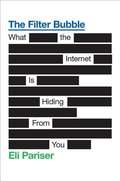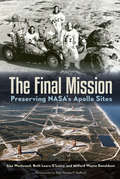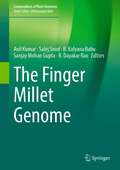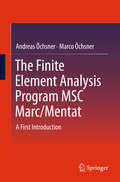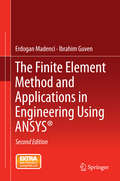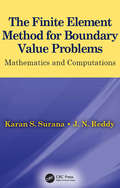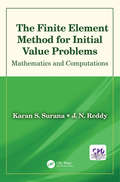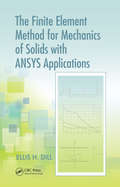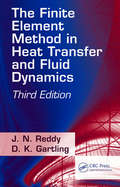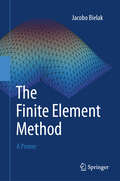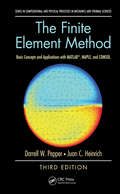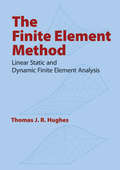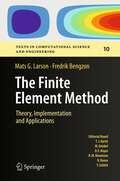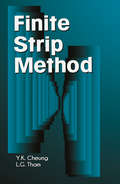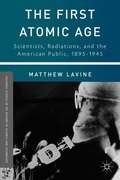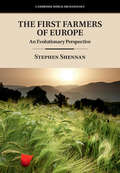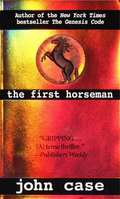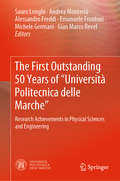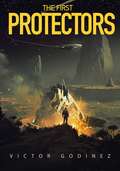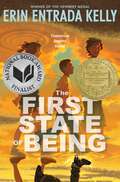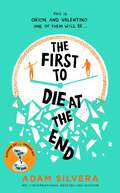- Table View
- List View
The Fight Over Food: Producers, Consumers, and Activists Challenge the Global Food System (Rural Studies)
by Wynne Wright Gerad Middendorf“One problem with the food system is that price is the bottom line rather than having the bottom line be land stewardship, an appreciation for the environmental and social value of small-scale family farms, or for organically grown produce.” —Interview with farmer in Skagit County, WashingtonFor much of the later twentieth century, food has been abundant and convenient for most residents of advanced industrial societies. The luxury of taking the safety and dependability of food for granted pushed it to the back burner in the consciousness of many. Increasingly, however, this once taken-for-granted food system is coming under question on issues such as the humane treatment of animals, genetically engineered foods, and social and environmental justice. Many consumers are no longer content with buying into the mainstream, commodity-driven food market on which they once depended. Resistance has emerged in diverse forms, from protests at the opening of McDonald’s restaurants worldwide to ever-greater interest in alternatives, such as CSAs (community-supported agriculture), fair trade, and organic foods. The food system is increasingly becoming an arena of struggle that reflects larger changes in societal values and norms, as expectations are moving beyond the desire for affordable, convenient foods to a need for healthy and environmentally sound alternatives. In this book, leading scholars and scholar-activists provide case studies that illuminate the complexities and contradictions that surround the emergence of a “new day” in agriculture.The essays found in The Fight Over Food analyze and evaluate both the theoretical and historical contexts of the agrifood system and the ways in which trends of individual action and collective activity have led to an “accumulation of resistance” that greatly affects the mainstream market of food production. The overarching theme that integrates the case studies is the idea of human agency and the ways in which people purposefully and creatively generate new forms of action or resistance to facilitate social changes within the structure of predominant cultural norms. Together these studies examine whether these combined efforts will have the strength to create significant and enduring transformations in the food system.
The Fight Over Food: Producers, Consumers, and Activists Challenge the Global Food System (Rural Studies)
by Wynne Wright Gerad Middendorf“One problem with the food system is that price is the bottom line rather than having the bottom line be land stewardship, an appreciation for the environmental and social value of small-scale family farms, or for organically grown produce.” —Interview with farmer in Skagit County, WashingtonFor much of the later twentieth century, food has been abundant and convenient for most residents of advanced industrial societies. The luxury of taking the safety and dependability of food for granted pushed it to the back burner in the consciousness of many. Increasingly, however, this once taken-for-granted food system is coming under question on issues such as the humane treatment of animals, genetically engineered foods, and social and environmental justice. Many consumers are no longer content with buying into the mainstream, commodity-driven food market on which they once depended. Resistance has emerged in diverse forms, from protests at the opening of McDonald’s restaurants worldwide to ever-greater interest in alternatives, such as CSAs (community-supported agriculture), fair trade, and organic foods. The food system is increasingly becoming an arena of struggle that reflects larger changes in societal values and norms, as expectations are moving beyond the desire for affordable, convenient foods to a need for healthy and environmentally sound alternatives. In this book, leading scholars and scholar-activists provide case studies that illuminate the complexities and contradictions that surround the emergence of a “new day” in agriculture.The essays found in The Fight Over Food analyze and evaluate both the theoretical and historical contexts of the agrifood system and the ways in which trends of individual action and collective activity have led to an “accumulation of resistance” that greatly affects the mainstream market of food production. The overarching theme that integrates the case studies is the idea of human agency and the ways in which people purposefully and creatively generate new forms of action or resistance to facilitate social changes within the structure of predominant cultural norms. Together these studies examine whether these combined efforts will have the strength to create significant and enduring transformations in the food system.
The Filing Cabinet: A Vertical History of Information
by Craig RobertsonThe history of how a deceptively ordinary piece of office furniture transformed our relationship with information The ubiquity of the filing cabinet in the twentieth-century office space, along with its noticeable absence of style, has obscured its transformative role in the histories of both information technology and work. In the first in-depth history of this neglected artifact, Craig Robertson explores how the filing cabinet profoundly shaped the way that information and data have been sorted, stored, retrieved, and used.Invented in the 1890s, the filing cabinet was a result of the nineteenth-century faith in efficiency. Previously, paper records were arranged haphazardly: bound into books, stacked in piles, curled into slots, or impaled on spindles. The filing cabinet organized loose papers in tabbed folders that could be sorted alphanumerically, radically changing how people accessed, circulated, and structured information.Robertson&’s unconventional history of the origins of the information age posits the filing cabinet as an information storage container, an &“automatic memory&” machine that contributed to a new type of information labor privileging manual dexterity over mental deliberation. Gendered assumptions about women&’s nimble fingers helped to naturalize the changes that brought women into the workforce as low-level clerical workers. The filing cabinet emerges from this unexpected account as a sophisticated piece of information technology and a site of gendered labor that with its folders, files, and tabs continues to shape how we interact with information and data in today&’s digital world.
The Filter Bubble
by Eli PariserAn eye-opening account of how the hidden rise of personalization on the Internet is controlling-and limiting-the information we consume. In December 2009, Google began customizing its search results for each user. Instead of giving you the most broadly popular result, Google now tries to predict what you are most likely to click on. According to MoveOn. org board president Eli Pariser, Google's change in policy is symptomatic of the most significant shift to take place on the Web in recent years-the rise of personalization. In this groundbreaking investigation of the new hidden Web, Pariser uncovers how this growing trend threatens to control how we consume and share information as a society-and reveals what we can do about it. Though the phenomenon has gone largely undetected until now, personalized filters are sweeping the Web, creating individual universes of information for each of us. Facebook-the primary news source for an increasing number of Americans-prioritizes the links it believes will appeal to you so that if you are a liberal, you can expect to see only progressive links. Even an old-media bastion like The Washington Post devotes the top of its home page to a news feed with the links your Facebook friends are sharing. Behind the scenes a burgeoning industry of data companies is tracking your personal information to sell to advertisers, from your political leanings to the color you painted your living room to the hiking boots you just browsed on Zappos. In a personalized world, we will increasingly be typed and fed only news that is pleasant, familiar, and confirms our beliefs-and because these filters are invisible, we won't know what is being hidden from us. Our past interests will determine what we are exposed to in the future, leaving less room for the unexpected encounters that spark creativity, innovation, and the democratic exchange of ideas. While we all worry that the Internet is eroding privacy or shrinking our attention spans, Pariser uncovers a more pernicious and far- reaching trend on the Internet and shows how we can- and must-change course. With vivid detail and remarkable scope, The Filter Bubble reveals how personalization undermines the Internet's original purpose as an open platform for the spread of ideas and could leave us all in an isolated, echoing world. .
The Final Mission: Preserving NASA's Apollo Sites
by Lisa Westwood Beth O'Leary Milford W. DonaldsonThe world will always remember Neil Armstrong and Buzz Aldrin for their first steps on the moon, yet few today hold in respect the sites that made these and other astronauts' journeys possible. Across the American landscape and on the lunar surface, many facilities and landing sites linked to the Apollo program remain unprotected. Some have already crumbled to ruins--silent and abandoned. The Final Mission explores these key locations, reframes the footprints and items left on the moon as cultural resources, and calls for the urgent preservation of this space heritage. Beginning with the initiation of the space race, the authors trace the history of research, training, and manufacturing centers that contributed to lunar exploration. From the early rocket test stands of Robert H. Goddard, to astronaut instruction at Meteor Crater, to human and primate experiments at Holloman Air Force Base, innumerable places proved critical to developing the equipment for exploring space, surviving the journey, and returning to Earth safely. Despite their significance to the history of human spaceflight, many landmarks face the threat of damage or destruction. Most alarming is that the rapid advancement of technology renders stations obsolete long before they are deemed worthy of preservation. Moreover, the lack of precedence for protecting off-planet artifacts poses a unique challenge for space archaeology. While NASA's 2011 recommendations for spacefarers suggest avoiding close proximity to this cultural landscape, the authors advocate stronger routes of preservation and present models for safeguarding space history--both on Earth's surface and beyond.
The Finger Millet Genome (Compendium of Plant Genomes)
by B. Dayakar Rao Anil Kumar Salej Sood B. Kalyana Babu Sanjay Mohan GuptaThis book is the first comprehensive compilation of deliberations on domestication, genetic and genomic resources, breeding, genetic diversity, molecular maps & mapping of important biotic stress as well as nutritional quality traits, genome sequencing, comparative genomics, functional genomics and genetic transformation. The economic, nutritional and health benefits especially antioxidants mediated antiaging effects of finger millet are also discussed. It also presents the input use efficiency, wide adaptation, post-harvest processing and value addition of the crop. Altogether, the book contains about 300 pages over 16 chapters authored by globally reputed experts on the relevant field in this crop. This book is useful to the students, teachers and scientists in the academia and relevant private companies interested in genetics, pathology, molecular genetics and breeding, genetic engineering, structural and functional genomics and nutritional quality aspects of the crop. This book is also useful to seed and pharmaceutical industries.
The Finite Element Analysis Program MSC Marc/Mentat
by Andreas Öchsner Marco ÖchsnerBased on simple examples, this book offers a short introduction to the general-purpose finite element program MSC Marc, a specialized program for non-linear problems (implicit solver) distributed by the MSC Software Corporation, which is commonly used in academia and industry. Today the documentation of all finite element programs includes a variety of step-by-step examples of differing complexity, and in addition, all software companies offer professional workshops on different topics. As such, rather than competing with these, the book focuses on providing simple examples, often single-element problems, which can easily be related to the theory that is discussed in finite element lectures. This makes it an ideal companion book to classical introductory courses on the finite element method.
The Finite Element Method and Applications in Engineering Using ANSYS®
by Erdogan Madenci Ibrahim GuvenThis textbook offers theoretical and practical knowledge of the finite element method. The book equips readers with the skills required to analyze engineering problems using ANSYS®, a commercially available FEA program. Revised and updated, this new edition presents the most current ANSYS® commands and ANSYS® screen shots, as well as modeling steps for each example problem. This self-contained, introductory text minimizes the need for additional reference material by covering both the fundamental topics in finite element methods and advanced topics concerning modeling and analysis. It focuses on the use of ANSYS® through both the Graphics User Interface (GUI) and the ANSYS® Parametric Design Language (APDL). Extensive examples from a range of engineering disciplines are presented in a straightforward, step-by-step fashion. Key topics include: * An introduction to FEM * Fundamentals and analysis capabilities of ANSYS® * Fundamentals of discretization and approximation functions * Modeling techniques and mesh generation in ANSYS® * Weighted residuals and minimum potential energy * Development of macro files * Linear structural analysis * Heat transfer and moisture diffusion * Nonlinear structural problems * Advanced subjects such as submodeling, substructuring, interaction with external files, and modification of ANSYS®-GUI Supplementary materials for this book may be downloaded from http://extras. springer. com. This convenient online feature, which includes color figures, screen shots and input files for sample problems, allows for regeneration on the reader's own computer. Students, researchers, and practitioners alike will find this an essential guide to predicting and simulating the physical behavior of complex engineering systems.
The Finite Element Method for Boundary Value Problems: Mathematics and Computations (Applied and Computational Mechanics)
by Karan S. Surana J. N. ReddyWritten by two well-respected experts in the field, The Finite Element Method for Boundary Value Problems: Mathematics and Computations bridges the gap between applied mathematics and application-oriented computational studies using FEM. Mathematically rigorous, the FEM is presented as a method of approximation for differential operators that are mathematically classified as self-adjoint, non-self-adjoint, and non-linear, thus addressing totality of all BVPs in various areas of engineering, applied mathematics, and physical sciences. These classes of operators are utilized in various methods of approximation: Galerkin method, Petrov-Galerkin Method, weighted residual method, Galerkin method with weak form, least squares method based on residual functional, etc. to establish unconditionally stable finite element computational processes using calculus of variations. Readers are able to grasp the mathematical foundation of finite element method as well as its versatility of applications. h-, p-, and k-versions of finite element method, hierarchical approximations, convergence, error estimation, error computation, and adaptivity are additional significant aspects of this book.
The Finite Element Method for Initial Value Problems: Mathematics and Computations
by J. N. Reddy Karan S. Surana<p>Unlike most finite element books that cover time dependent processes (IVPs) in a cursory manner, The Finite Element Method for Initial Value Problems: Mathematics and Computations focuses on the mathematical details as well as applications of space-time coupled and space-time decoupled finite element methods for IVPs. Space-time operator classification, space-time methods of approximation, and space-time calculus of variations are used to establish unconditional stability of space-time methods during the evolution. Space-time decoupled methods are also presented with the same rigor. Stability of space-time decoupled methods, time integration of ODEs including the finite element method in time are presented in detail with applications. Modal basis, normal mode synthesis techniques, error estimation, and a posteriori error computations for space-time coupled as well as space-time decoupled methods are presented. This book is aimed at a second-semester graduate level course in FEM.
The Finite Element Method for Mechanics of Solids with ANSYS Applications (Advances in Engineering Series)
by Ellis H. DillWhile the finite element method (FEM) has become the standard technique used to solve static and dynamic problems associated with structures and machines, ANSYS software has developed into the engineer's software of choice to model and numerically solve those problems. An invaluable tool to help engineers master and optimize analysis, The Finite El
The Finite Element Method in Heat Transfer and Fluid Dynamics (Applied and Computational Mechanics)
by J. N. Reddy D.K. GartlingAs Computational Fluid Dynamics (CFD) and Computational Heat Transfer (CHT) evolve and become increasingly important in standard engineering design and analysis practice, users require a solid understanding of mechanics and numerical methods to make optimal use of available software. Considered to be among the very best in the field, this masterwork from renowned experts J. N. Reddy and D. K. Gartling is the latest version of a book that has long been relied upon by practicing engineers, researchers, and graduate students. Noted for its powerful methodology and clear explanations of the subject, this third edition contains considerably more workable exercises and examples associated with problems in heat conduction, incompressible viscous flow, and convection heat transfer. It also uses applied examples to illustrate applications of FEM in thermal and fluid design analysis.
The Finite Element Method: A Primer
by Jacobo BielakThis textbook introduces the widely used numerical technique FEM in various engineering disciplines for the analysis of structures, heat transfer, fluid dynamics, and other physical phenomena. Appropriate for interested senior undergraduate engineering students and beginner graduate students in a one-semester introductory course, this book provides a clear understanding of the main issues in FEM. Looking at the FEM as a variational approximation method that uses localized piecewise polynomial basis functions for the solution of boundary-value problems (BVP) and initial boundary-value problems (IBVP), the book uses examples to apply this technique to various problems of physical interest, e.g., elasticity, heat conduction, advection-diffusion, etc. One-dimensional (1D) problems are presented first to make it easier to grasp the fundamental concepts associated with the formulation and application of the FEM; then, the methodology is extended to more challenging 2D and 3D problems that involve somewhat greater mathematical complexity. For simplicity, the book deals with problems that are specified in terms of a single set of state variables, such as displacements or temperature. Finally, due to the introductory nature of this text, only linear problems are considered.
The Finite Element Method: Basic Concepts and Applications with MATLAB, MAPLE, and COMSOL (3rd Edition) (Series in Computational and Physical Processes in Mechanics and Thermal Sciences)
by Darrell W. Pepper Juan C. Heinrich<p>This self-explanatory guide introduces the basic fundamentals of the Finite Element Method in a clear manner using comprehensive examples. Beginning with the concept of one-dimensional heat transfer, the first chapters include one-dimensional problems that can be solved by inspection. The book progresses through more detailed two-dimensional elements to three-dimensional elements, including discussions on various applications, and ending with introductory chapters on the boundary element and meshless methods, where more input data must be provided to solve problems. Emphasis is placed on the development of the discrete set of algebraic equations. The example problems and exercises in each chapter explain the procedure for defining and organizing the required initial and boundary condition data for a specific problem, and computer code listings in MATLAB and MAPLE are included for setting up the examples within the text, including COMSOL files. <p>Widely used as an introductory Finite Element Method text since 1992 and used in past ASME short courses and AIAA home study courses, this text is intended for undergraduate and graduate students taking Finite Element Methodology courses, engineers working in the industry that need to become familiar with the FEM, and engineers working in the field of heat transfer. It can also be used for distance education courses that can be conducted on the web. Highlights of the new edition include:- Inclusion of MATLAB, MAPLE code listings, along with several COMSOL files, for the example problems within the text. Power point presentations per chapter and a solution manual are also available from the web.</p>
The Finite Element Method: Linear Static and Dynamic Finite Element Analysis
by Thomas J. HughesOriginally developed to address specific areas of structural mechanics and elasticity, the finite element method is applicable to problems throughout applied mathematics, continuum mechanics, engineering, and physics. This text elucidates the method's broader scope, bridging the gap between mathematical foundations and practical applications. Intended for students as well as professionals, it is an excellent companion for independent study, with numerous illustrative examples and problems.The authors trace the method's development and explain the technique in clearly understandable stages. Topics include solving problems involving partial differential equations, with a thorough finite element analysis of Poisson's equation; a step-by-step assembly of the master matrix; various numerical techniques for solving large systems of equations; and applications to problems in elasticity and the bending of beams and plates. Additional subjects include general interpolation functions, numerical integrations, and higher-order elements; applications to second- and fourth-order partial differential equations; and a variety of issues involving elastic vibrations, heat transfer, and fluid flow. The displacement model is fully developed, in addition to the hybrid model, of which Dr. Tong was an originator. The text concludes with numerous helpful appendixes.
The Finite Element Method: Theory, Implementation, and Applications
by Fredrik Bengzon Mats G. LarsonThis book gives an introduction to the finite element method as a general computational method for solving partial differential equations approximately. Our approach is mathematical in nature with a strong focus on the underlying mathematical principles, such as approximation properties of piecewise polynomial spaces, and variational formulations of partial differential equations, but with a minimum level of advanced mathematical machinery from functional analysis and partial differential equations. In principle, the material should be accessible to students with only knowledge of calculus of several variables, basic partial differential equations, and linear algebra, as the necessary concepts from more advanced analysis are introduced when needed. Throughout the text we emphasize implementation of the involved algorithms, and have therefore mixed mathematical theory with concrete computer code using the numerical software MATLAB is and its PDE-Toolbox. We have also had the ambition to cover some of the most important applications of finite elements and the basic finite element methods developed for those applications, including diffusion and transport phenomena, solid and fluid mechanics, and also electromagnetics.
The Finite Strip Method (New Directions In Civil Engineering Ser. #17)
by Y. K. Cheung L. G. ThamThe increase in the popularity and the number of potential applications of the finite strip method has created a demand for a definitive text/reference on the subject. Fulfilling this demand, The Finite Strip Method provides practicing engineers, researchers, and students with a comprehensive introduction and theoretical development, and a complete treatment of current practical applications of the method.Written by experts who are arguably the world's leading authorities in the field, The Finite Strip Method covers both the classical strip and the newly developed spline strip and computed shape function strip. Applications in structural engineering, with particular focus on practical structures such as slab-beam bridges, box girder bridges, and tall buildings are discussed extensively. Applications in geotechnology are also covered, as are recently formulated applications in nonlinear analysis.The Finite Strip Method is a unique book, supplying much-needed information by well-known and highly regarded authors.
The First Atomic Age
by Matthew LavineAt the close of the 19th century, strange new forms of energy arrested the American public's attention in ways that no scientific discovery ever had before. This groundbreaking cultural history tells the story of the first nuclear culture, one whose lasting effects would be seen in the familiar "atomic age" of the post-war twentieth century.
The First Farmers of Europe: An Evolutionary Perspective (Cambridge World Archaeology )
by Stephen ShennanKnowledge of the origin and spread of farming has been revolutionised in recent years by the application of new scientific techniques, especially the analysis of ancient DNA from human genomes. <P><P>In this book, Stephen Shennan presents the latest research on the spread of farming by archaeologists, geneticists and other archaeological scientists. He shows that it resulted from a population expansion from present-day Turkey. Using ideas from the disciplines of human behavioural ecology and cultural evolution, he explains how this process took place. The expansion was not the result of 'population pressure' but of the opportunities for increased fertility by colonising new regions that farming offered. The knowledge and resources for the farming 'niche' were passed on from parents to their children. However, Shennan demonstrates that the demographic patterns associated with the spread of farming resulted in population booms and busts, not continuous expansion.<P> The first book to synthesise new ancient DNA results revolutionising our understanding of the spread of farming.<P> Provides a coherent account of the processes involved in the spread of farming.<P> The account is framed in terms of new ideas from the fields of human behavioural ecology and cultural evolution.
The First Horseman
by John CaseOn the Norwegian sea, an icebreaker forges its way through frozen waters to a remote island in the Arctic, carrying a scientific team that hopes to unearth the bodies of long-dead miners. Washington Post reporter Frank Daly has the story of a lifetime. But his plan to join the scientists on their historic mission is ruined by a ferocious storm. When he meets up with the ship upon its return to port in Norway, it is clear that something has gone terribly wrong. Fear haunts the faces of the crew. No one will talk. And someone wants Daly to stop asking questions. But the more he uncovers, the more dangerous the stakes become. Until at last he comes face-to-face with a shocking secret, a secret that pitches him into a harrowing race to prevent nothing less than . . . apocalypse.
The First Knowledge Economy
by Margaret C. JacobEver since the Industrial Revolution debate has raged about the sources of the new, sustained western prosperity. Margaret Jacob here argues persuasively for the critical importance of knowledge in breaking the Malthusian trap during the period from 1750 to 1850, first in Britain and then in selected parts of northern and western Europe. This is a new history of economic development in which minds, books, lectures and education become central. She shows how, armed with knowledge and know-how and inspired by the desire to get rich, entrepreneurs emerged within an industrial culture wedded to scientific knowledge and technology. She charts how, across a series of industries and nations, innovative engineers and entrepreneurs sought to make sense and a profit out of the world around them. Skilled hands matched minds steeped in the knowledge systems new to the eighteenth century to transform the economic destiny of western Europe.
The First Outstanding 50 Years of “Università Politecnica delle Marche”: Research Achievements in Physical Sciences and Engineering
by Sauro Longhi Michele Germani Andrea Monteriù Alessandro Freddi Emanuele Frontoni Gian Marco RevelThe book describes the significant multidisciplinary research findings at the Università Politecnica delle Marche and the expected future advances. It addresses some of the most dramatic challenges posed by today’s fast-growing, global society and the changes it has caused. It also discusses solutions to improve the wellbeing of human beings. The book covers the main research achievements in the different disciplines of the physical sciences and engineering, as well as several research lines developed at the university’s Faculty of Engineering in the fields of electronic and information engineering, telecommunications, biomedical engineering, mechanical engineering, manufacturing technologies, energy, advanced materials, chemistry, physics of matter, mathematical sciences, geotechnical engineering, circular economy, urban planning, construction engineering, infrastructures and environment protection, technologies and digitization of the built environment and cultural heritage. It highlights the international relevance and multidisciplinarity of research at the university as well as the planned research lines for the next years.
The First Protectors: A Novel
by Victor GodinezThe last thing Ben Shepherd wanted was another war. But sometimes the universe won’t take no for an answer. His body and spirit mangled by a lifetime of combat, Shepherd, a retired Navy SEAL, has retreated to the desolate desert of New Mexico to heal his wounds and dodge his demons. All he wants now is peace and quiet. Both are shattered one starry night, when an alien ship crashes nearby. Out of the ship crawls the last, dying member of a conquered civilization. It’s been shot down by an extraterrestrial enemy, the vanguard of a ravenous force hunting for a new homeland. With its last gasp, the wounded alien injects Shepherd with a high-tech serum that gives him near superhuman powers. Now, with a new body but a soul as fractured as ever, Shepherd becomes the reluctant leader of the human resistance against the coming invasion. With enemies on all sides, the man who couldn’t bear the guilt of seeing one more friend die in battle now finds himself charged with protecting the entire planet.
The First State of Being
by Erin Entrada KellyWINNER OF THE NEWBERY MEDALA FINALIST FOR THE 2024 NATIONAL BOOK AWARDA NEW YORK TIMES BESTSELLER INDIE BESTSELLERChicago Public Library Best Fiction for Older Readers of 2024Shelf Awareness Best Books of 2024 for Kids and TeensBookPage Best Middle Grade of 2024Common Sense Media Best Books of 20242025 Excellence in Children’s and Young Adult Science Fiction Notable ListWhen twelve-year-old Michael Rosario meets a mysterious boy from the future, his life is changed forever. From bestselling author Erin Entrada Kelly, also the winner of the Newbery Medal for Hello, Universe and a Newbery Honor for We Dream of Space, this novel explores themes of family, friendship, trust, and forgiveness. The First State of Being is for fans of Rebecca Stead’s When You Reach Me.It's August 1999. For twelve-year-old Michael Rosario, life at Fox Run Apartments in Red Knot, Delaware, is as ordinary as ever—except for the looming Y2K crisis and his overwhelming crush on his sixteen-year-old babysitter, Gibby. But when a disoriented teenage boy named Ridge appears out of nowhere, Michael discovers there is more to life than stockpiling supplies and pining over Gibby.It turns out that Ridge is carefree, confident, and bold, things Michael wishes he could be. Unlike Michael, however, Ridge isn’t where he belongs. When Ridge reveals that he’s the world’s first time traveler, Michael and Gibby are stunned but curious. As Ridge immerses himself in 1999—fascinated by microwaves, basketballs, and malls—Michael discovers that his new friend has a book that outlines the events of the next twenty years, and his curiosity morphs into something else: focused determination. Michael wants—no, needs—to get his hands on that book. How else can he prepare for the future? But how far is he willing to go to get it?A story of time travel, friendship, found family, and first loves, this thematically rich novel is distinguished by its voice, character development, setting, and exploration of the issues that resonate with middle grade readers.Finalist for the National Book Award and Winner of the Newbery Medal.
The First to Die at the End: The prequel to the international No. 1 bestseller THEY BOTH DIE AT THE END!
by Adam SilveraIn this prequel to the NO. 1 INTERNATIONAL BESTSELLING phenomenon of TIKTOK fame, They Both Die at the End, two new strangers spend a life-changing day together after Death-Cast make their first fateful calls. '[A] heart-pounding story [full] of emotion and suspense.' Kirkus 'An extraordinary book with a riveting plot.' BooklistMeet Orion and Valentino. It&’s the night before Death-Cast goes live, and there&’s one question on everyone&’s mind: Can Death-Cast actually predict death, or is it an elaborate hoax? Orion Pagan has waited years for someone to tell him that he&’s going to die, given his serious heart condition. Valentino Prince has a long and promising future ahead of him and only registered for Death-Cast after his twin sister nearly died in a car accident. Orion and Valentino cross paths in Times Square and immediately feel a deep connection. But when the first End Day calls go out, their lives are changed for ever – one of them receives a call . . . the other doesn&’t. Told with acclaimed author Adam Silvera&’s signature bittersweet touch, this story celebrates the lasting impact that people have on each other and proves that life is always worth living to the fullest. PRAISE FOR ADAM SILVERA: 'There isn't a teenager alive who won't find their heart described perfectly on these pages.' Patrick Ness, author of The Knife of Never Letting Go 'Adam Silvera is a master at capturing the infinite small heartbreaks of love and loss and grief.' Nicola Yoon, author of Everything, Everything 'A phenomenal talent.' Juno Dawson, author of Clean and Wonderland 'Bold and haunting.' Lauren Oliver, author of Delirium


